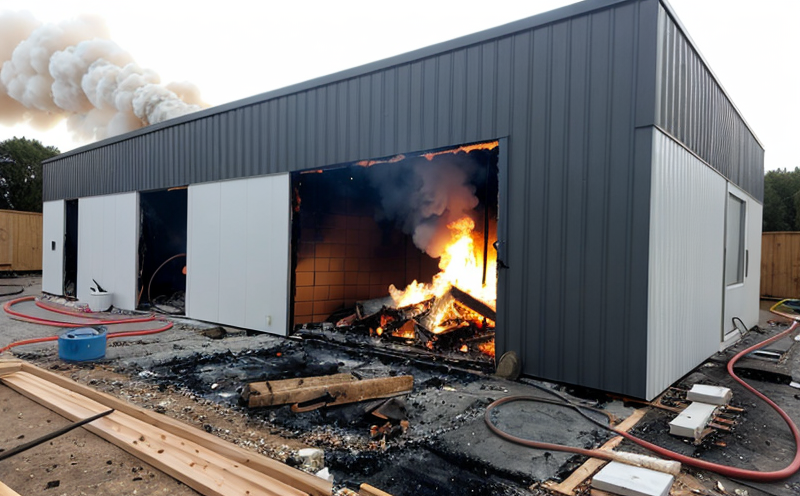Reaction-to-Fire Testing of Aerated Concrete Panels
The reaction-to-fire testing of aerated concrete panels is a critical procedure to ensure the safety and integrity of buildings in case of fire. This test evaluates the performance of insulation materials, particularly those used in cladding systems, under exposure to high-temperature conditions. The primary goal is to assess how effectively these materials can resist ignition, prevent flame spread, and avoid contributing to the rapid development of a fire.
Aerated concrete panels are widely used due to their excellent thermal insulating properties. However, they also pose certain risks when exposed to fire. The test focuses on determining the limiting oxygen index (LOI), which helps in understanding how much oxygen is required for combustion to occur. Additionally, it measures the flame spread index (FSI) and smoke production rate (SPR) to evaluate the material's behavior under fire conditions.
During testing, specimens are subjected to controlled combustion environments according to international standards such as ISO 834 or ASTM E136. The test setup typically includes a furnace where the sample is exposed to temperatures up to 850°C for durations ranging from 30 minutes to several hours depending on the specific requirements of the project.
Specimen preparation involves cutting samples to standard dimensions and ensuring they are free from defects that could affect test results. The testing apparatus used includes furnaces, thermocouples, gas flow meters, and data acquisition systems to monitor temperature, oxygen concentration, and other parameters accurately.
The outcome of the reaction-to-fire tests is crucial for compliance with building codes and regulations worldwide. For instance, in Europe, the Eurocode EN 13501-1 specifies that certain cladding materials must pass this test before being used in construction projects. In North America, NFPA 286 provides similar requirements.
Understanding the results of these tests allows architects and engineers to make informed decisions regarding material selection for safer buildings. It ensures that even if a fire breaks out within or near a building, the cladding system does not exacerbate the situation by fueling flames or producing excessive smoke.
| Applied Standards | Description |
|---|---|
| ISO 834:1995 | Test method for determining the resistance of materials to ignition and flame spread in a vertical configuration. |
| ASTM E136-2017 | Standard test methods for apparent thermal mass, heat of combustion, and residual carbon content of building materials by calorimetry. |
The importance of accurate testing cannot be overstated. Misinterpretation or incorrect application of these standards can lead to substandard products entering the market, potentially compromising public safety during emergencies.
- Ensures compliance with local and international regulations.
- Provides data for continuous improvement in product development.
- Safeguards against liability issues related to non-compliant materials.
In conclusion, reaction-to-fire testing is essential for evaluating the fire performance of aerated concrete panels. By adhering strictly to established protocols and utilizing appropriate instrumentation, laboratories can provide reliable data that contribute significantly to safer building practices.
Applied Standards
The reaction-to-fire testing of aerated concrete panels must comply with several international standards to ensure accuracy and consistency. These include:
| Standard | Description |
|---|---|
| ISO 834:1995 | This standard outlines the methods for determining the resistance of materials to ignition and flame spread in a vertical configuration. It specifies the dimensions, conditions of test specimens, and procedures for conducting tests under controlled environments. |
| ASTM E136-2017 | The American Society for Testing and Materials (ASTM) standard provides guidelines on how to perform calorimetric testing to measure apparent thermal mass, heat of combustion, and residual carbon content. This helps in understanding the energy release characteristics of materials during fires. |
These standards are crucial because they provide a framework for consistent testing procedures across different laboratories worldwide. Compliance with these standards ensures that the results obtained from various labs are comparable, enhancing trust and reliability in fire safety assessments.
Why Choose This Test
- Regulatory Compliance: Many countries require materials used in cladding systems to pass reaction-to-fire tests. Ensuring compliance helps avoid legal penalties and maintains good standing with regulatory bodies.
- Safety Assurance: By choosing this test, you ensure that the materials will behave predictably under fire conditions, reducing risks associated with potential failures during emergencies.
- Product Improvement: The insights gained from these tests can be used to refine manufacturing processes and improve material properties continuously.
In addition to regulatory compliance and safety assurance, selecting this test offers several other benefits. It allows manufacturers to demonstrate their commitment to quality and reliability, which is increasingly important in today's competitive market. Moreover, it provides valuable data that can inform decision-making throughout the product lifecycle from R&D to final application.
Environmental and Sustainability Contributions
- Eco-friendly Materials: Aerated concrete panels are made from recycled aggregates, reducing waste sent to landfills. This contributes positively towards sustainable resource management.
- Thermal Efficiency: Their high thermal insulating properties reduce energy consumption in buildings, leading to lower carbon footprints over time.
The reaction-to-fire testing of aerated concrete panels also supports environmental sustainability by ensuring that these materials meet stringent safety standards without compromising on their beneficial attributes. This dual approach enhances both the performance and ecological footprint of construction projects utilizing such materials.





